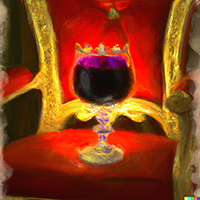Cabernet Sauvignon: The King of Reds Is a Half Breed?
Posted by Matteo Lahm on 31st Jan 2023
Cabernet Sauvignon is one of the most popular wine grapes in the world. Its flavor and complexity have made it a favorite among winemakers and consumers alike. The origins of Cabernet Sauvignon are not as well-known but what is known might come as a surprise.
Cabernet Sauvignon is a hybrid grape, created by the combination of two other wine grapes. Surprisingly, one of those parents is a white grape yet, Cabernet Sauvignon is both the Rolls Royce and monster truck of reds. Let’s talk about how this random little Cabernet Franc and Sauvignon Blanc lovechild grew to thrive in vineyards all over the world. While the flavor of Cabernet Sauvignon is the result of the combination of two very different grapes, there is also a genetic explanation for its characteristics. The genetic makeup of Cabernet Sauvignon is complex and contains genetic markers from both of its parent grapes. Cabernet Franc is responsible for the grape's deep color and traditional flavors. The markers from Sauvignon Blanc, on the other hand, are responsible for the grape's herbal and grassy notes. When combined, these two grapes create a unique flavor and complexity that is unmatched by other grapes.

Genetically, Cabernet Sauvignon has three sets of chromosomes, unlike the two sets of chromosomes of its parent grapes. This extra set of chromosomes give it its higher tannin content, and more intense flavor. Cabernet Sauvignon also has higher levels of two special compounds, anthocyanins and phenolic compounds, making it more resistant to fungal disease than mom and dad. Anthocyanins and phenolic compounds protect against fungus by providing antifungal and antimicrobial defense. These compounds can inhibit the ability of fungus to produce spores and reduce the spread.
To understand the flavor profile of Cabernet Sauvignon, it is important to first understand the flavor profiles and characteristics of its parents. Cabernet Franc is often described as having notes of black pepper, tobacco, and herbs. It is also known for producing flabby wines. Cabernet Franc has lower acidity than Cabernet Sauvignon and explains why Cabernet Franc is rarely found as a single varietal wine. Sauvignon Blanc, on the other hand, is known for its grassy, citrus, and herbal notes. It is also known for bright and crisp acidity, which is also signature of Cabernet Sauvignon. The combination of these grapes is the best of both worlds and more. Cabernet Sauvignon wines are often bursting with flavors of blueberry, blackberry, plum, citrus, herbs and more.
Cabernet Sauvignon is known for its bold flavor and intense tannins, while Cabernet Franc tends to be softer and more subtle. Cabernet Sauvignon has a higher sugar content, allowing for a fuller body, and has higher levels of tannins, leading to a more intense flavor. Cabernet Sauvignon also has higher levels of acidity, giving it a crisper finish. The combination of these qualities gives Cabernet Sauvignon what many consider to be a superior flavor profile compared to Cabernet Franc.
There is however one aspect of Cabernet Franc that exceeds Cabernet Sauvignon: color. Cabernet Franc is one of the darkest and deepest reds in existence. It is so dark, it is almost inky. This might seem ironic considering it lacks the overall punch of a Cabernet Sauvignon. For this reason, Cabernet Franc is almost always blended in smaller amounts with Cabernet Sauvignon to deepen its hue.
The fruit forwardness of Cabernet Sauvignon also explains why it is also blended with Merlot. Some consider Cabernet Sauvignon by itself to be too fruity and jammy. Merlot’s herbal qualities soften Cabernet Sauvignon and give it a more balanced and complex flavor profile and more structure. For this reason, the blend of Cabernet Sauvignon, Merlot and Cabernet Franc is one of the most notable and popular blends in the world. In France, it is called the Bordeaux and openly discloses that it is a blend. The US version is called the Meritage. In the US however, labeling laws say you do not have to disclose the presence of other varietals if the primary is at least 50% of the blend. Often when you buy a California Cab, it contains Merlot and Cabernet Franc.

As for its history, Cabernet Sauvignon is believed to have originated in the Bordeaux region of France. Whoever did this is lost to history but, some genius decided to cross-pollinate these two grapes in the mid-17th century, resulting in the marvel that is the Cabernet Sauvignon grape. It has since spread throughout the world. The Cabernet Sauvignon grape is well-suited to a variety of climates and soils. Cabernet Sauvignon is a formidable grape variety because of its adaptability and resistance to disease. It is also known for its ability to age well, making it a favored grape for winemakers. Cabernet Sauvignon can thrive in a wide range of climates, soil types and elevations, making each iteration distinct.
French Bordeaux wines are known for their intense tannins, deep color, and nuanced flavors. Italian Cabernet Sauvignon comes mainly from Tuscany and Lazio, where it shows off bright fruitiness and herbaceous notes. In the United States, Cabernet Sauvignon is grown mainly in California. These wines are known for their ripe fruit flavors and smooth tannins. The Barossa Valley in Australia is the source of much of their Cabernet Sauvignon wines and known for their intense fruit flavors and firm structure. South African Cabernet Sauvignon is grown mainly in Stellenbosch and celebrated for their rich, ripe fruit flavors and smooth tannins. Chilean Cabernet Sauvignon’s stronghold is the Maipo Valley and has intense, spicy flavors and firm structure. That is quite a list!
So here’s another! If the regional variety were not impressive enough, its versatility as a blending grape is also remarkable.
Short list of grapes blended with Cabernet Sauvignon and where they are made:
- Merlot (Bordeaux, France and California)
- Cabernet Franc (Bordeaux, France and California)
- Petit Verdot (Bordeaux, France and California)
- Malbec (Argentina and France)
- Sangiovese (Tuscany and Lazio, Italy)
- Syrah (Australia, California, and France)
- Zinfandel (California)
- Carmenere (Chile)
- Tempranillo (Spain)
- Mourvedre (France, Spain, Australia)
- Grenache (Australia, France, Spain)
If you are a Cabernet Sauvignon lover, you will never run out of choices, blends or surprises. If you like to make it, there are many different Cabernet Sauvignon kits available for you to try. One thing is for sure, Cabernet Sauvignon’s reputation as the king of red wine grapes is well deserved, even if one of its parents is a white grape.

